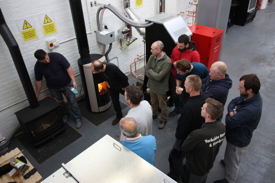Burning ambition

Around 1.5 million UK homes have wood-burning stoves and they continue to grow in popularity. Mike Harvey of HETAS explains why good maintenance practice is vital, and why installers can take the lead in helping users choose the correct fuel and keep the installation in good working order.
In order to deliver the best service to customers, installers fitting wood burning stoves need to think beyond the installation, approaching each job with the life cycle of the stove in mind. This means taking the time to offer customers good maintenance advice and well-informed aftercare. Such valuable advice will not only ensure the customer gets the most of out their appliance, it is also a sure-fire way of securing return business and increasing chances of recommendation.
So what advice should installers give to their customers regarding stove maintenance?
What to burn?
There is now a wide variety of highly efficient appliances ranging from the traditional to contemporary, designed to burn biomass pellet and mineral fuels. Much of an appliance’s maintenance requirement is determined by the type of fuel it burns.
For wood-burning stoves, drier wood is very much better for your stove and for the environment. Wet logs give out much less useful heat and will blacken the glass in the stove as the fire wastes heat boiling off moisture. We would always recommend that users burn logs that are accredited as ‘Ready to Burn’ under the Woodsure scheme. These have been properly sourced and seasoned with up to 20% moisture content. Burnt in the right Defra-exempt appliances "Ready to Burn" logs and approved wood briquettes help in meeting DEFRA’s air quality requirements. Installers can also suggest that customers invest in a moisture meter which they can pick up for around £20 and will help estimate the moisture content of fuel used. This helps ensure that the wood they burn is dry enough and therefore at its most efficient. In terms of efficiency, it’s better to burn hardwoods such as beech and ash as these take longer to burn and yield more useful heat.
 |
| Wood burning stoves like this one from Chesney’s are an increasingly popular form of domestic heating. |
One of the most important points is for installers to demonstrate how to light and effectively operate a new stove on installation. Many manufacturers' instruction books give great hints and HETAS has leaflets that customers can read to get the best from their stove into the future.
One tip installers can give their customers is on the arrangement of their fuel, always ensuring customers do not to overfill the appliance. Fuel should be arranged in a way which ensures air and combustion gases mix for an efficient burn. Making a ‘hashtag’ formation out of stacked kindling around a fire lighter with one single log on top, bark side down, is a tried and tested formation.
Installers should also carry a carbon monoxide alarm to demonstrate where this should be placed and how it can be tested.
General housekeeping
Regular appliance checks and cleaning are crucial to the stove’s maintenance. Like any product in continuous use they do require attention by the user and routine servicing and sweeping. Installers, servicing businesses and chimney sweeps can be found on the HETAS website. All solid fuel appliances should be routinely serviced by an engineer at the interval stated by the appliance manufacturer. HETAS recommends that routine servicing of the appliance is undertaken at least once a year when burning smokeless fuels and at least twice a year when burning wood or bitumous coal.
Installers can demonstrate how to clear the throat plates and advise that this should be done at least once a month, to reduce the risk of soot deposits igniting and to ensure a clear flue. They can also encourage homeowners to check that the stove’s rope seal on the door remains air-tight. Over time, seals become compressed and can allow additional air into the stove. This slightly reduces the stove’s ability to control the flame and therefore you can lose efficiency.
Sweeping
More comprehensive checks and cleaning should be carried out by a chimney sweep.
 |
|
Installer training helps ensure better operational efficiency for end-users. |
Greater use means more chimney sweeping and maintenance. It is also vitally important to consider options for existing chimneys, whether they are fit to be used, their structural integrity and ability to convey the products of combustion. It may be that a chimney will require ‘relining’ or work required to ensure its structure is sound.
Training
HETAS’ Service & Maintenance course is designed to ensure engineers are equipped with the knowledge and practical skills to undertake such work.
HETAS is aware that there are businesses that don’t wish to undertake installation work; professional chimney sweeps, installers who may be nearing retirement, local authorities with housing stock using solid fuel as a primary heat source and tenants who may have installed their own appliances. HETAS training has been designed to be two days of practical, hands-on training to optimise the time invested.
Mike Harvey is training & technical support manager at HETAS. For information and training details see the link below.







